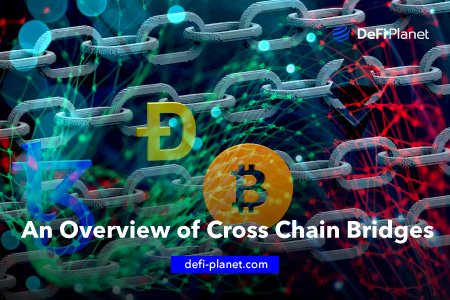Last updated on July 9th, 2023 at 07:10 pm
Different blockchains exist, and the development in this space has increased the need for unique chains with varying consensus mechanisms and operations to communicate with one another. Gone are the days when blockchains were restricted and didn’t need inter-communication channels.
With the rise of decentralized finance, NFTs, and the metaverse, these networks must allow individuals to exchange digital assets, decentralized apps, and smart contracts.
This is where the concept of cross-chain bridges or blockchain bridges originated. In this article, we will explore the concept of a cross-chain bridge, the reasons behind it, and the most common types.
What is a Cross Chain Bridge?
A cross-chain bridge, also known as a blockchain bridge, is an infrastructure designed to link multiple blockchains with one another, allowing crypto enthusiasts and developers to move their decentralized applications, digital assets, and smart contracts seamlessly.
Many of these bridges connect Ethereum- the foremost smart contract ecosystem- to the newer generations of blockchains. Newer networks know the importance of Ethereum can’t be ignored. To attract more developers to build their decentralized apps on the infrastructure, these networks incorporate a cross-chain feature that functions with bridges.
It solves a major issue in the blockchain space, which was the inability of networks to work with one another. Bridges create a channel for different blockchains, that were once restricted, to interact with one another, exchanging data, assets, and smart contracts.
Cross-chain bridges do not affect the independence of the blockchains that it connects, and vice versa.
What are the uses of cross chain bridges?
Cross-chain bridges have several use cases in the blockchain space, which will be discussed below.
• Transfer of smart contracts
Blockchains are being designed to be EVM-compatible, allowing developers to move their smart contracts from Ethereum to their network.
• Token transfer
A major utility of blockchain bridges rests in transferring tokens between two networks with varying protocols and rules. When a bridge is used to transfer a coin from one network to the other, the cross-chain bridge holds the coins and mints an equivalent on the other end of the bridge.
Typically, the crypto to be transferred is locked in a smart contract on one end, while on the other end, the equivalent amount of the new token is minted or given to the user. In reality, the tokens did not move.
What are the types of cross chain bridges?
Blockchain bridges can be trust-based or trustless cross-chain bridges.
• Trust-based bridges
The trust-based bridge is designed to be fast and affordable especially when the user is transferring a large volume of tokens. Though they are fast and cheap, they are not as secure or reliable as their counterparts.
Trust-based bridges are also called centralized bridges and they depend on a centralized authority to function. Users have to place their trust in an intermediary for the process to be effective.
• Trustless bridge
Trustless bridges are also called decentralized bridges, and they follow the mechanism of a regular blockchain. It is safer than the trust-based bridge because different networks are involved in the validation process.
Trust is placed in the code that operates the bridge. Before a transaction is verified, multiple nodes must reach a consensus based on the rules incorporated in the code. People tend to trust this more because of the absence of a centralized authority that can abuse its power.
Common cross chain bridges
In the blockchain ecosystem, many cross-chain bridges connect one network to another. Some of these will be briefly analyzed below.
Tezos Wrap Protocol Bridge
Like almost every bridge in this list, the Tezos Wrap Protocol Bridge links the Tezos blockchain to the Ethereum network. Bender Labs developed it to facilitate the transfer of digital assets between the two networks. The bridge can wrap different ERC20 and ERC721 tokens and then use them in decentralized finance apps.
Interlay
This is a trustless bridge built to connect Polkadot to Bitcoin and vice versa. With this blockchain bridge, people can mint Bitcoin-backed assets on Polkadot in a ratio of 1:1 as PolkaBTC. This will enable them to be utilized in different DeFi processes such as lending.
Darwinia
It is building permission and a trustless bridge that links multiple networks together. Darwinia is funded by a Web3 Foundation grant to create several bridges that link different networks to one another. The bridge crafted for the Ethereum network has been launched.
Binance Smart Chain Bridge
Binance Smart Chain has a bridge that links it to Ethereum. BSC is similar and compatible to Ethereum, as they both have smart contract features, though the fees on the former are cheaper.
Wormhole Bridge
This is a popular cross-chain bridge that connects two notable smart contract networks, Solana and Ethereum. People can exchange assets on both networks. The bridge was attacked in 2022, resulting in a loss of $321 million in cryptocurrencies, however, it has since been replenished.
Avalanche Bridge
The Avalanche bridge links the EVM-compatible network, Avalanche, with Ethereum. Holders of AVAX can move their assets to Ethereum through this bridge and vice versa. People can send their AVAX-based assets to a wallet like Metamask as long as it is configured.
ChainBridge
ChainSafe and Centrifuge designed this cross-chain bridge to connect Ethereum to Substrate-based blockchains.
ChainBridge is an asset-agnostic bridge that links multiple networks to Ethereum, as long as they are Substrate-based. This bridge allows the transfer of cryptocurrencies as well as non-fungible tokens. Its open-source nature allows developers to create their bridges that work with it to connect to other networks.
Bitcoin Cash SmartBCH Bridge
This bridge allows people to wrap their Bitcoin Cash and use them in DeFi apps. It connects bitcoin cash to Ethereum.
Criticism of cross chain bridges
Though blockchain bridges may be effective, they are plagued with issues. In recent times, cross-chain bridges have been victims of massive attacks with users losing millions of dollars worth of cryptocurrencies. An example is the Wormhole Bridge attack, where $321 million worth of cryptocurrencies got stolen in 2022.
A downside to blockchain bridges is centralization. Users have to hand over their tokens to a centralized authority before they can get the new token they need.
Vitalik Buterin is a notable critic of blockchain bridges due to the vulnerabilities he believes they possess. According to the founder of Ethereum, the concept of linking multiple chains of varying consensus mechanisms and rules together may have grave repercussions.
According to Buterin, the security limitation was a cogent reason that cross-chain bridges would not stand the test of time. In his thoughts, he believes that it was safer to store an asset on the native blockchain, instead of a non-native chain.
Buterin further argued that if cross-chain bridges became a norm and a native blockchain faces a 51% attack, which forces the chain to reverse the bridge transaction, it could be disastrous. The transaction would have been confirmed in the non-native blockchain, leaving the cryptocurrencies in that transaction in an orphaned situation. If a reverse of a blockchain transaction occurs for any reason, it could lead to negative consequences for those in a non-native chain.
In Conclusion,
- Cross-chain bridges connect two blockchains, allowing people to move their digital assets, smart contracts, data, and even decentralized apps.
- Blockchain bridges can be trust-based and trustless bridges.
- Cross-chain bridges have risks that should be considered.
- Before using any blockchain bridge, it is important to conduct due diligence.
- Vitalik Buterin believes that the concept of moving assets from one network to the other via cross-chain bridges has vulnerabilities.
- There are examples of cross-chain bridges facing attacks, and one of the popular ones was the attack on Wormhole Bridge in 2022.
If you would like to read more articles from DeFi Planet, follow us on Twitter, LinkedIn and Facebook.





















